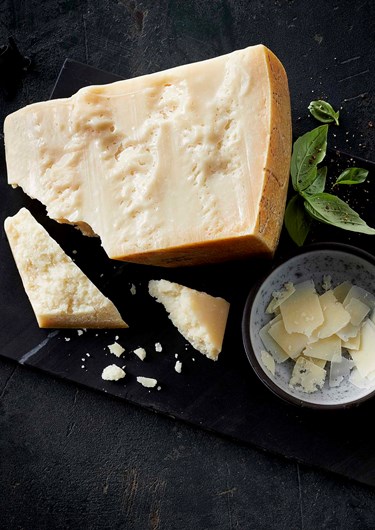
Grana Padano
What is Grana Padano?
Aged for a minimum of 9 months, the origin of Grana Padano dates back to the Cistercian monks of the Chiaravalle Abbey. From the polders of northern Italy, the cheese is produced with milk from free-range cows that are let to graze on fresh forage and silage.
Full-bodied, this hard cheese delivers a savoury and nutty touch with a dense and somewhat flaky texture. Creamy, mild and with a lingering aftertaste, it can be enjoyed on its own or as an accoutrement to your dish.
A heritage unmatched by most cheeses, Grana Padano is in a class of its own, unique in nuances of both taste and texture.
How is Grana Padano made?
Like a painter caresses his canvas with purpose and precision, so does the artisans curating and producing Grana Padano. A single misstep could spoil the cheese, emphasising that skill and artisanship is key during the entire process.
Production starts by pouring fresh milk into copper cauldrons along with whey and rennet. This helps form enough curd to produce two wheels of cheese. After being treated to a temperature meant to stimulate the natural bacteria, the curd is separated and allowed to settle. Having rested, the broken curd is set in a wheel-shaped mould and soaked in brine for at least 2 weeks. With the salting finished, the wheels are ready for aging. No less than 9 months after being set to age, the cheese is inspected for colour, scent and texture. With everything in the clear, the cheese is finally given the title of Grana Padano.
Pure in ingredients, Grana Padano is free from artificial fillers, preservatives and additives, resulting in an unpasteurised and gluten free cheese. The addition of rennet however, makes this cheese unfit for vegetarians.
Substitutes for Grana Padano?
The ubiquity of granular Italian cheeses, have made finding one that suits your palate stress-free. Many share common traits, while at the same time offering unique qualities of their own.
Favoured in both gastronomy and home-cooking, Parmesan, or Parmigiano Reggiano, is packed with character. Mellow notes of roasted almonds covered in caramelised butter provide a smooth sensation with a sharp finish.
For a sharper, more intense flavour, Pecorino Romano serves to ramp up the aromas of butter and roasted nuts. Made from raw sheep’s milk, this cheese makes itself known.
Curious about the world of cheese? Here's everything you need to know about how to store, serve and cut cheese!




